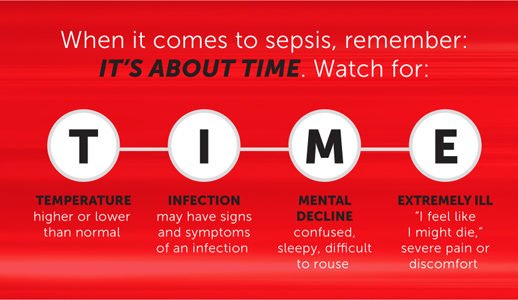
It’s important to remember sepsis can affect anyone, regardless of age, health status, or background. The Sepsis Alliance’s Faces of Sepsis™ stories allow those affected by sepsis to share their experiences of illness, treatment, recovery, and loss.
The collected stories aim to capture the diversity of people who had sepsis—some describe a quick recovery while others cover the long-term effects of post-sepsis syndrome (PSS). Each experience is different, but all Faces of Sepsis stories play a vital role. They help those who have been impacted by sepsis learn that they are not alone.
Susan Branvold, First District Health Unit in Bottineau County, North Dakota, recently shared the story of her husband’s sepsis battle.
“In 2019, my husband had hip surgery and a kidney stone. Over Labor Day weekend, he became nauseated and was vomiting, had an elevated temperature and low blood pressure. Having had prior kidney stones, he felt his symptoms were probably related to a kidney stone. He worked that day driving a school bus. I picked him up after work and took him to the walk-in clinic.
The clinic provider immediately sent us to the Emergency Room (ER) at SMP – St. Andrew’s. They did a urine specimen and culture and started a broad-spectrum antibiotic. I drove him to Catholic Health Initiatives (CHI) in Bismarck. He had a kidney stone lodged that was not allowing the urine to pass. He had surgery to put in a stent and was hospitalized for five days and went home on a pic line and IV antibiotics.
He was initially started on three antibiotics. Thankfully, the Bottineau ER lab did a culture with sensitivity as two of the three antibiotics were not working. It is due to this care and proactive action that my husband is still here today. I never realized how close I was to losing him.“
 More than 1.7 million Americans are diagnosed with sepsis each year, resulting in an estimated 270,000 deaths annually.
More than 1.7 million Americans are diagnosed with sepsis each year, resulting in an estimated 270,000 deaths annually.
Susan’s story serves as a powerful reminder that the earlier sepsis is detected and treated, the better odds a person with the condition has for full recovery.
Additional Resources:
- National Sepsis Alliance | Long-Term Care
- Great Plains QIN: STOP And TELL Tool
- Great Plains QIN: Connecting the Dots – Antibiotic Stewardship, Immunization, Sepsis
- Great Plains QIN Blog Post: Surviving Sepsis: What Happens Afterwards?

Listen To Our Podcast: Q-Tips For Your Ears!
TIME is Sepsis, Have You Heard: Sepsis is a medical emergency as important to understand as stroke and heart attack. Learn the symptoms and what you should say to your healthcare provider when you suspect sepsis.
